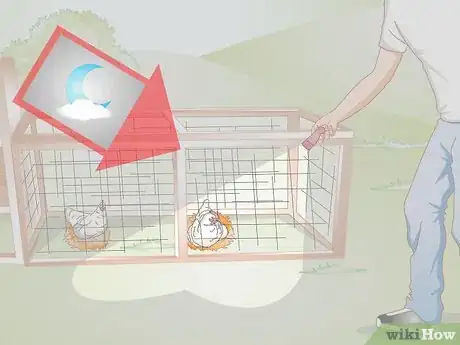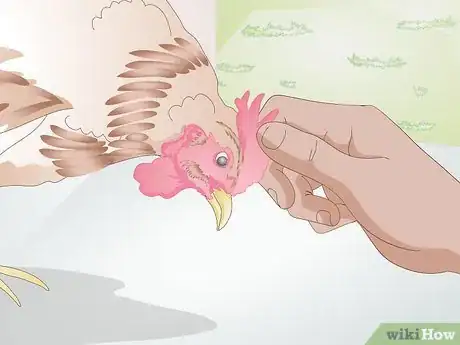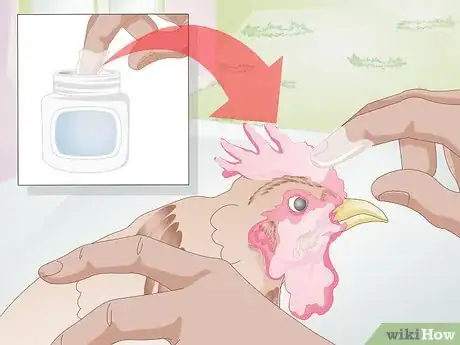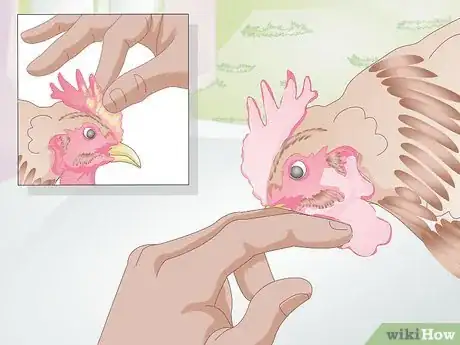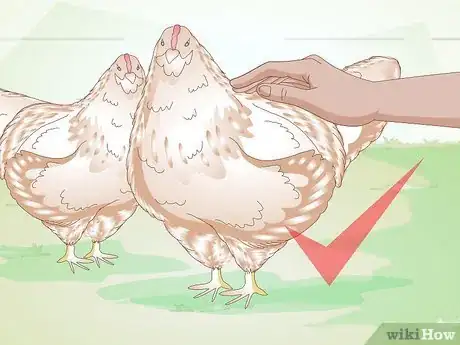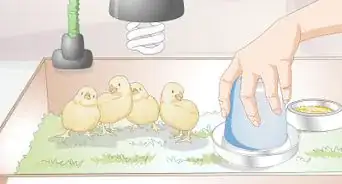This article was co-authored by wikiHow Staff. Our trained team of editors and researchers validate articles for accuracy and comprehensiveness. wikiHow's Content Management Team carefully monitors the work from our editorial staff to ensure that each article is backed by trusted research and meets our high quality standards.
wikiHow marks an article as reader-approved once it receives enough positive feedback. In this case, 93% of readers who voted found the article helpful, earning it our reader-approved status.
This article has been viewed 74,849 times.
Learn more...
Chickens are hardy animals that can handle the cold. However, chickens' exposed skin, in combs and wattles, can suffer badly from frostbite in freezing temperatures. When the temperature dips, you can protect their skin and prepare their environment to keep the combs safe. A few preventative measures can keep your chickens happy and warm.
Steps
Preventing Frostbite
-
1Wait until the evening. To keep a better control over your birds, wait until they have entered the roost for the night before applying any covering. Overnight is when the temperature will be lowest, so it is when your chickens will be most susceptible to frostbite.[1]
-
2Check for signs of frostbite. Before adding anything to your chicken's comb, make sure they aren't already suffering from frostbite. You'll notice because those areas of the comb will be black. You can still apply a covering, but just be careful when applying jelly to this skin, as it will be very sensitive.[2]
- If you notice frostbite on the skin, treat it where possible. Move your chicken to a warm area. Soak a clean cloth in lukewarm water and hold against the frostbitten areas. Do not use direct heat like a dryer, or rub the comb.
- Combs do not grow back, so don't break off the blackened tips. This will cause problems for the chicken in regulating body heat, especially during the summer.[3]
Advertisement -
3Apply petroleum jelly. Cover the chicken's wattle and comb liberally with petroleum jelly. Massage the jelly into any exposed red skin around the head. Once you have rubbed some in, leave an extra thick coat onto the comb and wattle.[4]
-
4Reapply when skin is dry. You want to make sure your birds' combs stay warm, so be prepared to pick them up and touch the skin. If the comb feels dry, you should apply another coat. If it feels oily or greasy, the original coat is still there.[7]
-
5Get cold-weather chicken breeds. Some breeds are better in cold conditions, and you may consider choosing to raise these if you are in a cold climate. When looking for cold-weather birds, focus on breeds with larger bodies and smaller combs. This means more body fat for keeping warm and less exposed skin vulnerable to frostbite.[8]
- Some of the best breeds for cold weather are Ameraucanas, Ancona, Black Australorps, Black Giant, Blue Andalusian, Brahma, Buff Orpingtons, Cochins, Delaware, Dominique, Langshan, New Hampshire, Plymouth Rocks, Rhode Island Red, Russian Orloff, Speckled Sussex and Wyandottes.
Creating a Warm Environment
-
1Ventilate the coop. While you want to avoid having a drafty coop, there should be some air circulation. Add screened windows near the overhang where the walls meet the roof. You can close windows during the night, as long as you remember to open them back up during the day.[9]
- It is important to keep the coop ventilated, and not sealed, to keep the environment safe. A sealed coop will trap humidity, which can lead to frostbite. You can also get a buildup of ammonia gas from the chickens' droppings, which will damage their lungs.
-
2Build wide roosting bars. To help prevent frostbite on your chickens' feet, they should have a roost wide enough for the hens to perch with their bodies covering the tops of their feet and the roost covering the bottom. Installing a 2x4 with the 4” side facing up is a good choice.[10]
-
3Use a heater. If you face particularly chilly winters, you may consider putting a small heater in the coop. You don't want the coop too warm, just a little above freezing. If the coop is too warm, your chickens won't get used to the cold weather.[11] [12]
- An electric light bulb is a good option, as it provides heat without being as much of a fire hazard, and will be cheaper to run.
-
4Change the bedding every few days. You want to reduce moisture in the coop, so don't allow your chickens to roost in wet bedding, especially in cold weather. Make sure the bedding material is both deep and dry, or else you'll be dealing with wet conditions, which can quickly lead to disease.[13]
-
5
-
6Make sure their water is fresh. You want to make sure your birds stay hydrated, so keep their water filled and clean. If you notice any ice beginning to form, break it up.[15]
Community Q&A
-
QuestionMy grandfather and I are starting a chicken farm. Since chickens don't survive winter often, he is planning to kill them at Halloween every year. How can I change his mind about this?
 Amy HarrisonTop AnswererChickens can easily survive winter and can easily avoid frostbite if you provide them with adequate items such as a heat lamp, appropriate sheltering, and protein rich feed. For the winter months you can keep your chickens locked up in a barn or coop to avoid frostbite.
Amy HarrisonTop AnswererChickens can easily survive winter and can easily avoid frostbite if you provide them with adequate items such as a heat lamp, appropriate sheltering, and protein rich feed. For the winter months you can keep your chickens locked up in a barn or coop to avoid frostbite. -
QuestionThere is snow coming and my chicks have hatched. How do I keep them warm?
 KarinTop AnswererKeep them under a heat-lamp in a warm place, which may mean keeping them indoors in your house. They won't survive out in the cold, even with a heat-lamp, without any other kind of heat source, so you will need to raise them as hatchlings indoors.
KarinTop AnswererKeep them under a heat-lamp in a warm place, which may mean keeping them indoors in your house. They won't survive out in the cold, even with a heat-lamp, without any other kind of heat source, so you will need to raise them as hatchlings indoors. -
QuestionMy rooster froze his crown, even though I was applying vaseline. Where can I find a little hat for him?
 Community AnswerThis sounds like a severe frostbite, so the only thing really to do without harming the little thing is to keep in indoors and warm! Keep the legs and feet warm the most, and make sure the crown is warm and rub it to get the blood moving in there again.
Community AnswerThis sounds like a severe frostbite, so the only thing really to do without harming the little thing is to keep in indoors and warm! Keep the legs and feet warm the most, and make sure the crown is warm and rub it to get the blood moving in there again.
References
- ↑ http://www.hobbyfarms.com/6-winter-tips-for-your-flock/
- ↑ http://www.tractorsupply.com/know-how_pets-livestock_chicken_how-to-prepare-your-chickens-for-winter
- ↑ http://www.fresheggsdaily.com/2014/01/treating-and-preventing-frostbite-in.html
- ↑ http://www.tractorsupply.com/know-how_pets-livestock_chicken_how-to-prepare-your-chickens-for-winter
- ↑ http://www.hobbyfarms.com/6-winter-tips-for-your-flock/
- ↑ http://www.fresheggsdaily.com/2014/01/treating-and-preventing-frostbite-in.html
- ↑ http://www.tractorsupply.com/know-how_pets-livestock_chicken_how-to-prepare-your-chickens-for-winter
- ↑ http://www.tractorsupply.com/know-how_pets-livestock_chicken_how-to-prepare-your-chickens-for-winter
- ↑ http://www.tractorsupply.com/know-how_pets-livestock_chicken_how-to-prepare-your-chickens-for-winter
- ↑ http://www.fresheggsdaily.com/2014/01/treating-and-preventing-frostbite-in.html
- ↑ http://www.tractorsupply.com/know-how_pets-livestock_chicken_how-to-prepare-your-chickens-for-winter
- ↑ http://www.hobbyfarms.com/6-winter-tips-for-your-flock/
- ↑ http://www.tractorsupply.com/know-how_pets-livestock_chicken_how-to-prepare-your-chickens-for-winter
- ↑ http://www.hobbyfarms.com/6-winter-tips-for-your-flock/
- ↑ http://www.tractorsupply.com/know-how_pets-livestock_chicken_how-to-prepare-your-chickens-for-winter
- ↑ http://www.hobbyfarms.com/6-winter-tips-for-your-flock/
About This Article
To protect your chicken’s comb from winter cold, cover its wattle and comb with petroleum jelly or coconut oil before evening time, when the temperatures are the coldest. You can also create a warmer environment by putting a small heater or an electric light bulb in the coop to keep it just above freezing, which will keep your chicken safe while allowing it to get used to the cold. While your coop needs to stay ventilated to keep the chicken’s lungs healthy, you can also consider closing the windows during the night to keep drafts out. In addition to warming the coop, supplement your chicken's diet with corn or scratch during the winter months, which will help it gain weight and stay warmer. To learn how build a roosting bar to prevent frostbite, keep reading!
